Last Updated on October 30, 2024 by Owen McGab Enaohwo
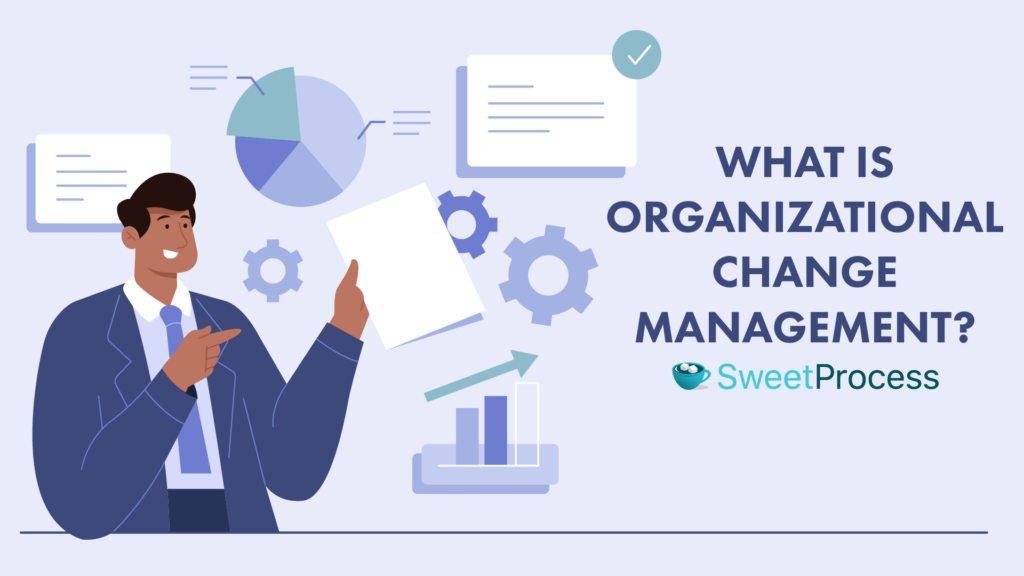
“If you’re not embarrassed by the first version of your product, you’ve launched too late.” — LinkedIn Founder Reid Hoffman.
Every successful company has experienced changes in its how and why until it metamorphoses into a fully successful company. Even for an already successful company, change is inevitable.
This article discusses executing and managing organizational changes and the tools that will make this easy for your team.
Check out SweetProcess and see how you can easily propose, execute, and manage productive changes in your company.
Table of Contents
What Is Organizational Change Management?
Why Organizational Change Management Is Important
7 Types of Organizational Change
9 Key Steps to an Effective Organizational Change Management
How to Manage New Changes in Your Organization With SweetProcess
8 Organizational Change Management Strategies for Driving Results
3 Organizational Change Management Examples You Can Learn From
5 Common Challenges (and Solutions) to a Seamless Organizational Change Management
Document and Manage New Changes in Your Company Seamlessly
What Is Organizational Change Management?

Organizational change management (OCM) is a framework for managing the effects of new processes, organizational structures, or cultures within an enterprise.
Every organization experiences periodic changes during its existence. These changes will significantly impact the business, including its processes, company output, people, and other stakeholders. The resulting impacts can be positive, resulting in greater efficiency and profitability. The consequences can also be negative, affecting the company’s reputation or profitability.
Organizational changes will always significantly impact the organization as a whole. Major shifts in personnel, company goals, service offerings, and operations are all considered different forms of organizational change.
It is important to effectively manage change while minimizing its potential negative impact. This is why a formal organizational change management process will always be required.
Matthew Ramirez, founder of Rephrasely and a Forbes 30 under 30 alumni, shared his insights on managing organizational change. He emphasized the role of communication and training.
Mathew is known for starting his change process by communicating the reason and necessity of the change to his team members. This triggered support and enthusiasm from the team members. The good thing is that he not only communicates before executing the change, he always has an open line of communication to ensure that employees are free to share their concerns.
At Rephrasely and other companies he has managed, Mathew helps provide comprehensive assistance and resources to help employees adapt. These include training sessions, mentorship programs, and regular check-ins.
His approach helped build trust and transparency, reducing pushback against the changes.
Why Organizational Change Management Is Important

Everyone knows that change is an indispensable concept in a thriving company, but most teams are unprepared to have management strategies. This is just like having child upbringing goals without the parent ready to ensure and enforce obedience. Below are some reasons you should consider change management when planning to execute a change in your company.
Eases the Pressure of Change
Every organization needs to change occasionally. This is especially true if you are in a competitive environment. Executing frequent changes puts you ahead of your competitors and makes it easy to realize your targets and accomplishments.
Change management helps you stay on top of those changes with the strategy and frameworks always in place.
Streamlines and Simplifies the Change Process
Change management will simplify things more than it seems to most people. Change is naturally scary to some employees, but managing it will help them understand that it is not as hard or scary as they think.
Aids Quick Implementation
The most effective change does not have to take long. A well-managed project will produce good results within a reasonable timeline.
Solves Recurring Problems
Change management will consider the problems faced with change execution in the past and how to combat them. Recurring problems in an organization indicate that something is wrong. Organizational change management will study this and highlight what must be changed to prevent such problems completely.
Saves Time and Cost of Change
Poorly managed projects tend to exceed planned timelines and budgets. Effective change management will help with cost management by preventing any delays and additional costs.
Tracks Progress and Changes
When a change process is properly managed, it is easy to see and monitor its progress and incorporate changes that may be needed along the way.
Ease of Tracing Faults
Change management makes it easy to know when things are going wrong. Assessing the how and why of issues that arise makes the process seamless and productive.
Fosters Transparency and Accountability
When a change process is being managed, all stakeholders will be well-informed of every detail. This makes transparency and accountability very realistic among all team members.
Want a tool that does it well? Check out SweetProcess and manage your changes like a pro!
7 Types of Organizational Change
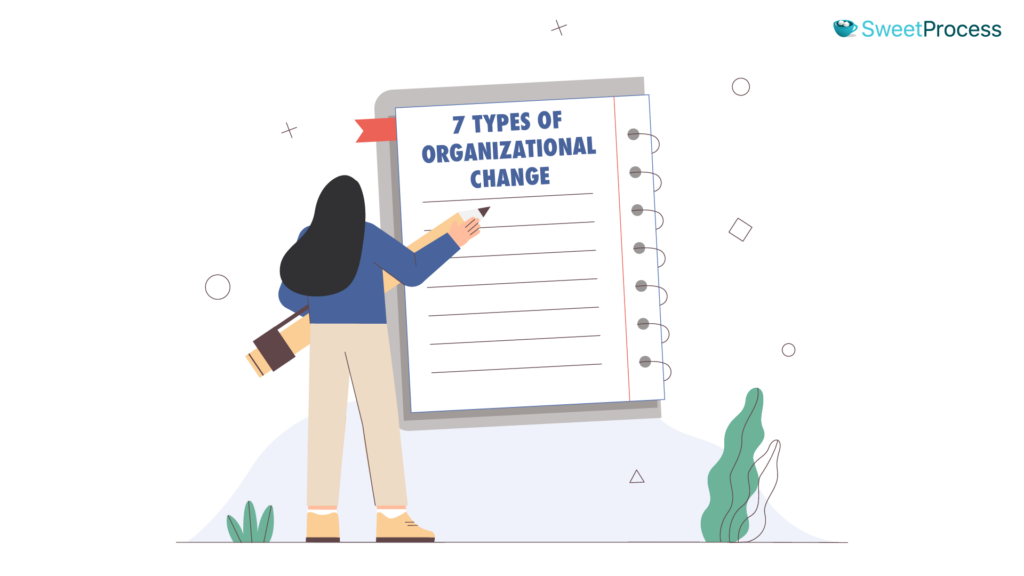
Changes in your organization can take different forms depending on the end goal. Some of the common organizational changes are discussed below:
Transformational Change
Transformational change in an organization means a complete overhaul toward shaping something entirely new. This often involves a total rebranding of an organization’s systems, processes, or culture. It’s a revolutionary process that may affect the company’s direction, vision, or mission.
Netflix is an example of transformational change. In 1997, Netflix started as a company that allowed its users to watch their desired movies based on a monthly subscription. The subscribed movies were then delivered to their subscribers’ homes as DVDs.
Netflix underwent a transformational change in 2007. They started streaming, a feature that eliminated the need for the users to wait for DVDs to arrive through the mail. This led to Netflix’s remarkable success because customers could watch all the content online without waiting for DVDs.
Transformational change can be challenging, but if strategically implemented, it can significantly improve performance. It typically requires a new vision, new goals, culture change, and new ways of doing things. Although it can be difficult to implement, the rewards can be significant.
Strategic Organizational Change
Implementing strategic changes in an organization helps boost competitive advantage in the market or respond to market opportunities or threats. A strategic change includes making changes to the business’s policies, structure, or processes. Upper management and the chief executive officer are mostly responsible for initiating a strategic change.
Strategic changes can come in the form of innovation or restructuring.
Strategic change involves using skills and resources to develop new ways to meet customers’ new and changing demands. An organization focusing on innovation will need to invest heavily in research and development activities.
In 2008, Domino’s faced the challenge of remaining relevant in the market. After seeing that increasing transactions were being performed online, some key players pushed the leaders to focus on the online ordering experience.
This innovation sets them apart from other pizza businesses today. The brand embraced new technology that matches its opportunity.
People-centric Organizational Change
All changes affect people. But people-centric changes are those that are centered on your team members. The most common examples of people-centric changes include bringing in new hires, changing job roles, instituting new leave policies, or even layoffs. When implementing a people-centric change, like any other change, the leadership must remember that employees will naturally resist change.
A people‐centric change requires transparency, communication, effective leadership, and an empathetic approach.
For instance, bringing on new team members requires effective employee onboarding and training. It will affect both the new hires and the established employees. It’s important to start by communicating the reason for hiring these new people to the team.
With people-centric change, change management teams can consider models like the Kübler-Ross Change Curve and Satir Change Model, which focus specifically on managing emotional reactions to change.
Structural Organizational Change
Structural changes are changes made to the organization’s structure that typically affect how the company is run. The need for a structural change might stem from internal or external factors like mergers and acquisitions, job duplication, changes in the market, and process or policy changes.
Structural changes include significant shifts in the management hierarchy, team organization, departmental responsibilities, chain of command, job structure, and administrative procedures.
These changes often overlap with people-centric changes as they directly impact most or all team members.
A structural organizational change happened in 2015 when Google restructured itself into Alphabet. Alphabet was made a conglomerate with several subsidiaries, including Google. The restructuring worked for their branding, positioning, and profit and loss reporting.
After the restructuring, the company created a more focused structure, with Google as a subsidiary. This allowed for more transparency and accountability for the various businesses under Alphabet.
The company also diversified its revenue stream and created separate companies for various businesses and ventures under it, such as Google, Waymo, and Verily.
The overall effect of Alphabet’s restructuring has improved the structure and organization of Google’s various businesses. This strategic move allowed the company to retain top talent, create internal competition, and separate its high-potential ventures from the parent brand. The restructuring boosted innovation and entrepreneurship within the company.
Lewin’s Change Management Model works well for structural changes because it focuses on creating a new status quo. It has three steps: unfreeze, change, and refreeze.
After you unfreeze the current processes, you move on to change. Once the changes are in place, you “refreeze” or solidify the change as the new status quo.
Technological Organizational Change
Technology change often involves introducing new software or systems to improve business processes.
With the current rate of technological evolution, market competition is high. Thus, technological changes within organizations are frequent and inevitable.
One of the major challenges of technological changes is that they may be improperly defined and poorly communicated. This can scare and frustrate your employees and trigger resistance.
The technological change management team should be in charge of identifying new technology and implementing a digital strategy for improved productivity and profitability.
An instance of technological change can be seen in Schneider Electric. Schneider Electric recently announced that it had created the first smart factory in the United States. The facility, located in Lexington, Kentucky, modernized a 1950s facility that led to a 90% reduction in paperwork and improved its mean time to repair by 20%.
In the 1990s, the company extended automation to improve the productivity of machining centers. Although the implementation was not fully integrated, it was a starting point for digital transformation. They moved on to automate material handling, which led to data integration for a material-flow-based process.
The facility implemented a centralized system for data sharing by building programs to measure the overall equipment effectiveness of its organizational assets and use augmented reality on the factory floor. Employees can access live operational data from any machine with augmented reality capabilities. They simply scan a QR code with a phone or tablet to see data in real time.
Unplanned Organizational Change
Unplanned change is the necessary change in an established process following unexpected events. Since an unplanned change cannot be predicted, you should have a change management team ready to manage change processes at all times.
A common example of unplanned organizational change is the need for many (or all) companies to change their model of operation at the onset of COVID-19.
Remedial Organizational Change
Remedial changes are reactionary measures that occur when a problem is identified, and a solution needs to be implemented. Since remedial changes are designed to address an issue, they mostly call for immediate action.
Remedial changes are not always ideal, but they are inevitable. It is easy to judge the success of remedial changes by assessing whether the problem was solved.
Remedial changes begin with an issue and end with a solution. It seems simple, but since these changes are reactionary, they can often involve some trial and error. Quick action means you won’t have as much time to plan or transition. The strategy comes into play through monitoring the change. The remedial change is only successful if the identified problem has been solved.
9 Key Steps to an Effective Organizational Change Management

If you plan to make a change that profits your organization, it’s important to follow well-defined steps that constitute the change management process. Below are the steps that can result in an effective change management process.
Define the Change and Align It to Business Goals
If there’s a need for a change, then something needs to be fixed. You should start by assessing your current business model and company strategy to determine the changes that must be made. Then, outline the benefits the new structure will bring your business.
Craft a Vision and Action Plan for the Organizational Change
Once you’ve determined the changes to be made, you should outline what you plan to achieve by implementing them.
It is important to strategize your organizational change based on vision, goals, and objectives. This is also the time to note the important parameters so you can track progress with the right KPIs ( key performance indicators).
Your action plan is expected to have a structure that includes:
- Major project milestones
- Short-term steps and objectives
- A training schedule for new processes
- Communication strategy based on the project timeline
- Key performance indicators
- Feedback channels
- Due dates and timelines for action steps
Create an Organizational Change Team
As a founder or manager, you don’t have to overwhelm yourself by doing it all. A change management team should be set up to plan and implement the various change initiatives. You can have a standby or ad-hoc team who will be charged to ensure that any change process in your organization is handled properly.
The members of the change management team have different roles, and the core roles are:
- Executive sponsor: This person is responsible for setting the vision for the change and defining the overall strategy.
- Change agents: These are the people whose task is to help employees enable the change. Try picking from the credible people in the team, those excited about the change, and those experienced about how things work in the organization. A change agent translates the executive sponsor’s vision into results that employees are expected to reach.
- Change lead: This should be an internal team member who understands the business very well and has prior experience leading a change. An external change lead is also a good idea. This should be a third party such as a consultant who’s an expert in change management and can provide assistance to the internal leaders when necessary.
- Communications team: These are people who communicate with different stakeholders and explain what the change is and the strategy to follow. They work closely with the executive sponsor to communicate the vision correctly.
- Training lead (team): People who develop training materials and facilitate the training. This is typically facilitated by the change agents.
The change team should be equipped with people with good leadership skills, credibility, communication ability, authority, analytical skills, and a sense of urgency.
Create a Timeline
Human beings are addicted to deadlines. If your project has no timeline, it may never get done. Assigning project timelines and letting your team members know when the goal should be reached is essential.
Always include exact dates for the steps in your timeline. Each major project management milestone should be broken down into incremental steps to avoid underestimating the time it will take to effect change.
This will help everyone discharge their assignments when due.
Implement the Changes
Now that all plans are in place, it’s time to make the change you wish to see. Charge all concerned team members with their assignments and see the changes fall into place—if all things are well planned.
Develop a Communication Strategy
To gain buy-in from your employees, they must be involved in the discussion and planning. You can achieve this by having a good communication strategy, adopting the right collaboration tools, and properly recording the necessary documents.
One of the tools to use is SweetProcess. It allows you to document all your processes, make them accessible to your team members, collaborate on the documents, and see all version histories when changes are made.
Notify Key Employees
Top and mid-level employees must be informed about this change before communicating it to the general team. You should get them involved in the planning and assign them roles in the change management team.
Review the Progress and Analyze the Results
To evaluate how changes are affecting an organization, you should develop different criteria to monitor the progress.
Your goals, KPIs, business objectives, execution speed, and performance improvement should be monitored periodically and the results analyzed to measure progress.
Manage the Change Resistance
People are naturally change-averse. Your employees might be unwilling to adapt to change because they are already comfortable with the status quo. Change resistance can be expressed in various ways, from blatant and public expression of dissatisfaction to latent forms when a person silently struggles and fails to adapt. Some of the causes of change resistance are:
- Lack of confidence and ability to successfully handle change
- Projecting change as a threat due to disruption of existing routine
- Insufficient skills and knowledge to handle the new processes
- Lack of understanding of the necessity of change
Proper management of change resistance is important to address all the issues listed above and many more. The change management team should provide enough orientation and training on why the change is necessary and how to handle the new processes.
You can check out how to manage your organizational changes with SweetProcess. Create an account here without a credit card.
How to Manage New Changes in Your Organization With SweetProcess

To successfully execute the changes in your organization, it’s important to start by standardizing every step of the process. All team members should document and access all your procedures and work instructions. Enough of handwritten documents, shared PDFs, and group chat items that make your procedures scattered all around.
SweetProcess makes it easy to document your organization’s processes. Consider your standard operating procedures, operational processes, employee onboarding, and industry policies.
Start managing your organizational change with SweetProcess today. It’s free.
How to Document Procedures, Processes, and Policies Using SweetProcess
Once logged in to your SweetProcess account, the instructions below will show you how to create a new procedure.
Step 1: Click on the “Procedures” tab.
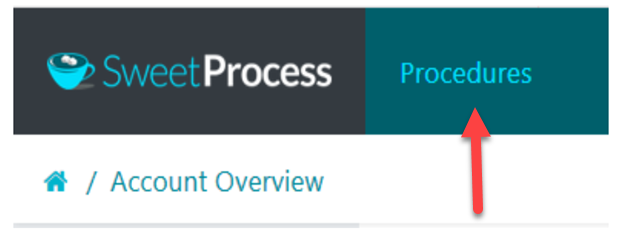
Step 2: Once the page opens, click the “Create Procedure” button at the top right of the page.

Step 3: Enter the title of the procedure.

Step 4: Add the procedure to a team or multiple teams.

Click on a checkbox to add the procedure to a team or on multiple checkboxes to add the procedure to multiple teams at the same time.
Step 5: Click on the “Continue” button.
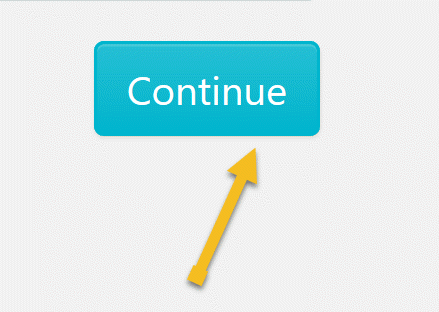
Step 6: Click on the title of the procedure to add a description.

Step 7: Click on the “Add a Step” button.

Step 8: Give the step a title and description.

Step 9: Attach files, images and/or embed videos to this step as needed.
Step 10: Click on “Finished Editing” to save the draft of the step.

Step 11: Click the “Add a Step” button to add a new step. Repeat steps 7, 8, 9, and 10 to enter and save the details of the new step.

Step 12: Repeat step 11 until you have added all the steps you need to document the procedure.
Step 13: As soon as you have documented all the steps of the procedure, click “Approve” at the top right-hand corner of the page to approve the procedure and make it live.
Note: If you’re not in the right position to approve the procedure, you can request approval by clicking on the “Request Approval” button as shown below.

Note: Processes and policies within SweetProcess can also be documented following similar steps.
How to Write Procedures, Processes and Policies with Artificial Intelligence (AI)
Writing a new procedure doesn’t mean you have to start from scratch. You can use our artificial intelligence feature (SweetAI) even if you are on a free plan. If you want to try this out, here are the steps to follow:
Step 1: On the SweetProcess home screen, click the “Procedures” tab.
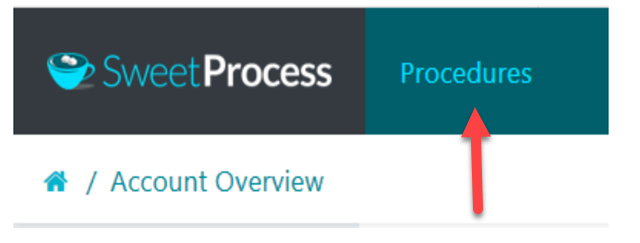
Step 2: Click on the “Create Procedure” button.
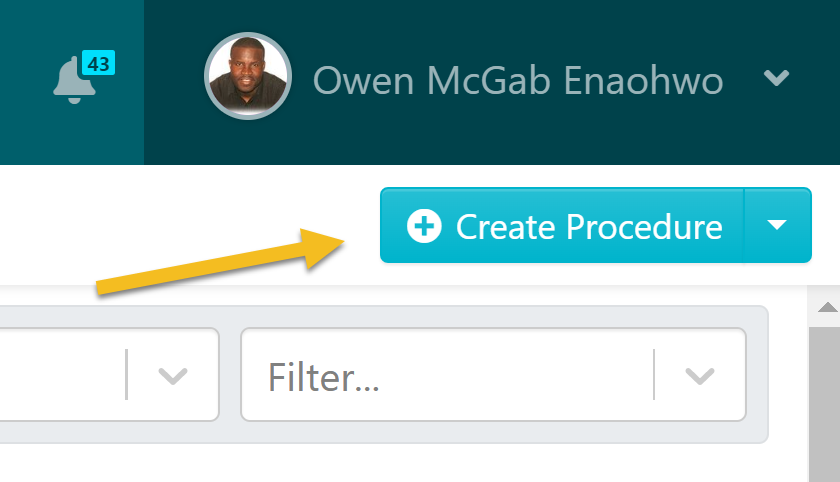
Step 3: Give the procedure a title.

Step 4: Click on the “Write with SweetAI” button.

Wait a few seconds for SweetAI to generate the procedure for you.
Step 5: Approve or edit the procedure SweetAI generated for you.
Once SweetAI automatically generates a procedure for you, you can either approve it or edit it further to add your finishing touches.
How the Version History Feature Works in SweetProcess for Procedures, Processes, and Policies
There is a reason why SweetProcess proves to be a more reliable tool for organizational change managers. The answer is in its version history feature. Going through a change in your organization does not mean you have to completely overhaul all the documented items you already have. The best bet is to make the necessary changes and execute them.
Version history in SweetProcess allows you to access all previous and current versions of your documents and the changes that have been made to them.
How sweet would it be if you hired a new employee and, without sitting them down to tell stories, he could go back in time and see how your company has evolved over time?
Here’s how to access the version histories of your documents in SweetProcess.
Step 1: Open the desired procedure and click on the clock icon.
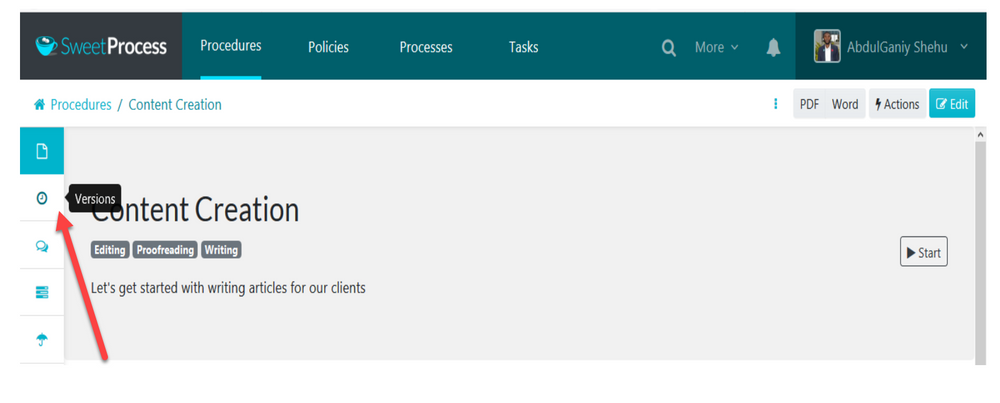
This will open up the version history sidebar menu that lists the current version of the procedure and all the other versions so far.
Step 2: After the version history sidebar menu opens up, click on the version of the procedure you want to see.
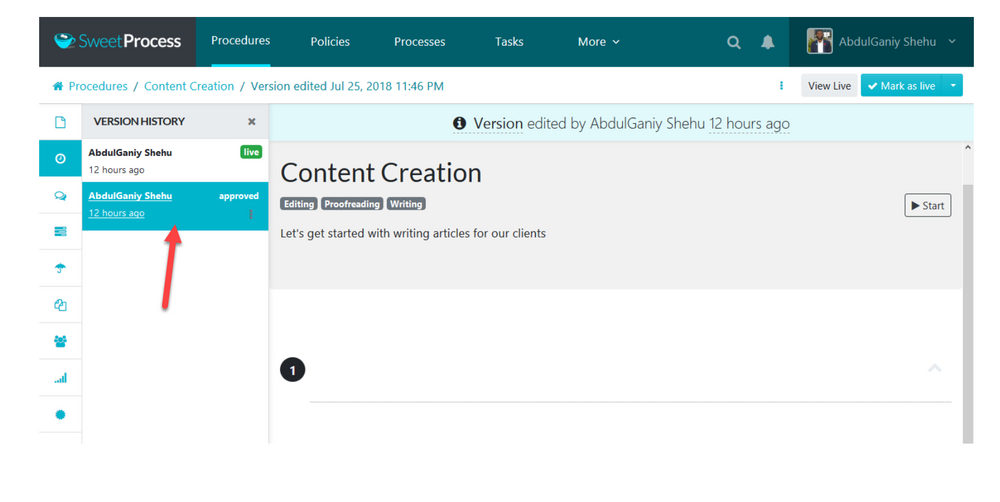
How to Collaborate With Team Members on SweetProcess
There is no team without collaboration. Collaborate with your team on SweetProcess to quickly execute changes and designate responsibilities.
The instructions below will show you how to comment, collaborate, or leave your feedback on a procedure in SweetProcess.
Step 1: While viewing a procedure, click the comment bubble icon.
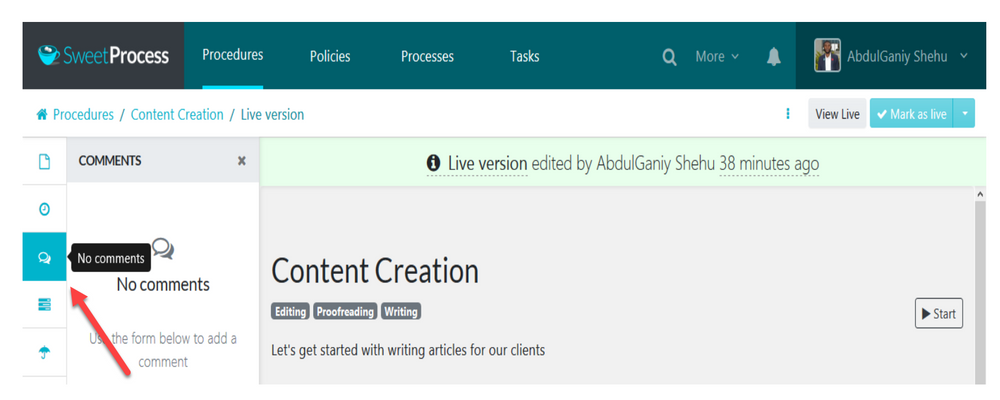
Step 2: Type your comment and click the paper plane icon to send it.
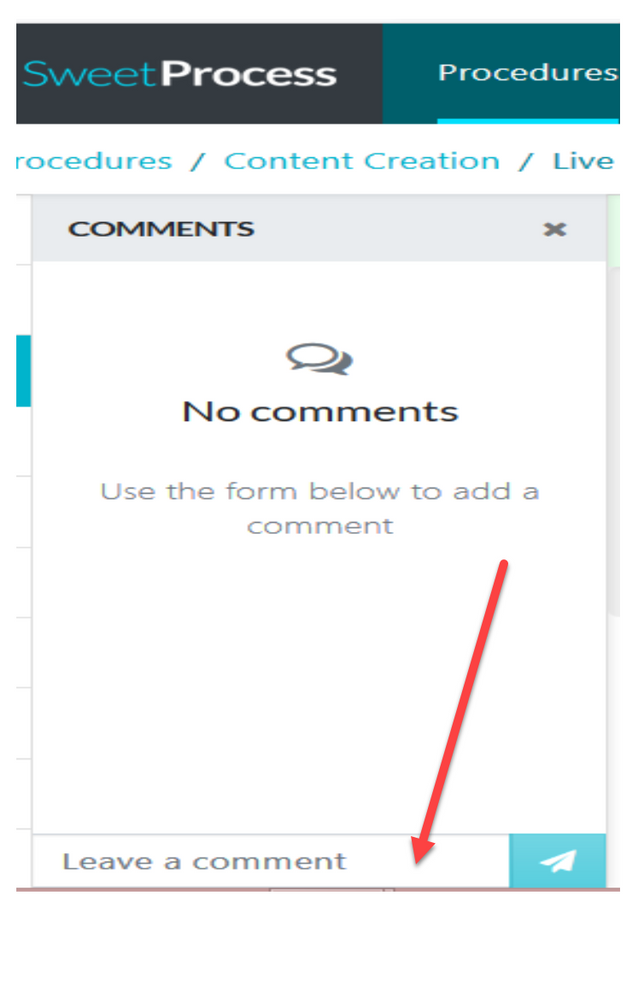
Every manager of the procedure or anyone who has commented on the procedure previously will be notified of your comment.
Employees notified of your comment by email can choose to respond inside SweetProcess or reply to the email to add a new comment.
Collaborate with your team members on SweetProcess today.
How to Assign Tasks to Team Members on SweetProcess
Another way to enhance collaboration is assigning different parts of a process to team members to ensure project completion. Follow the steps below to assign your team members a process or procedure as a task.
Step 1: Navigate to the process or procedure you want to assign.
Step 2: Click on the three-dots menu to the right of the procedure or process you want to assign.

Step 3: Select “Assign as Task.”
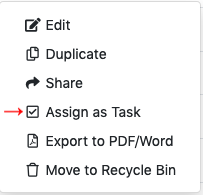
Step 4: On the “Assign Task” dashboard, select the right team member and the due date for the task.
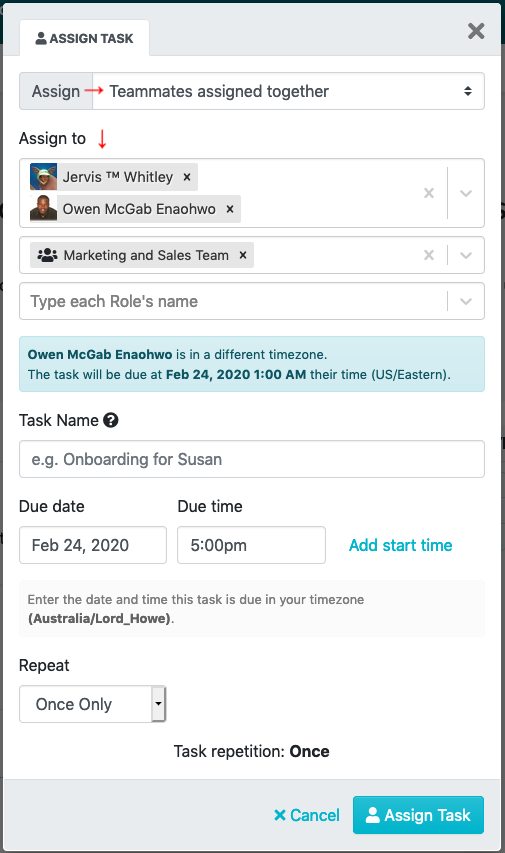
Create a free account with SweetProcess and assign your first task in minutes.
How to Ensure Change Compliance With SweetProcess Quiz
It is important to ensure that all team members are always on the same page during organizational change. One way to ascertain their clarity is to test their understanding of the new processes. Since SweetProcess comes with a quiz feature, this will help you know who among your team members understands the changes and who does not.
How to Create a Quiz on SweetProcess
Step 1: On the SweetProcess homepage, click on “More.”

Step 2: Select “Quizzes.”
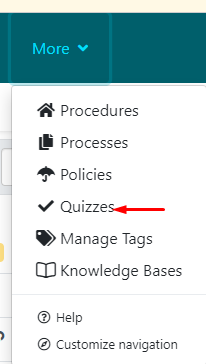
Step 3: Select “Create Quiz.”
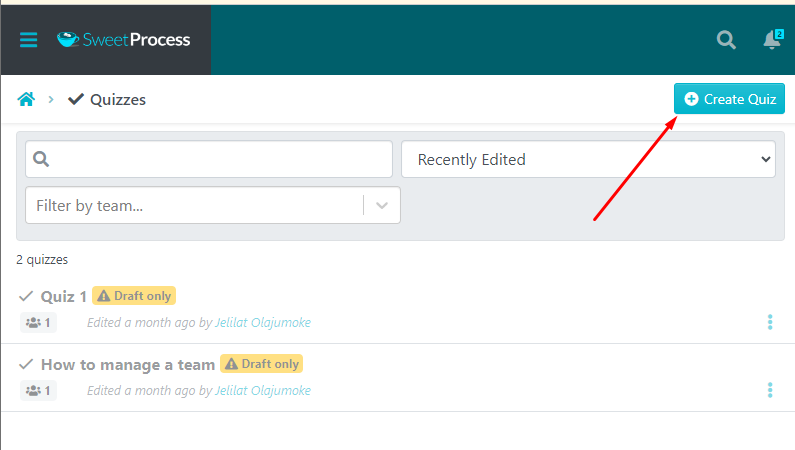
Step 4: Give the quiz a name and click “Continue.”

Step 5: Assign the quiz to the appropriate team on SweetProcess.

Step 6: Here, you can begin crafting multiple-choice questions about your company’s new procedures, policies, or processes.

Step 7: Choose the type of quiz: multiple-choice answer or open-ended answer.

Step 8: Click anywhere above the question section to assign duration and pass marks for the quiz.
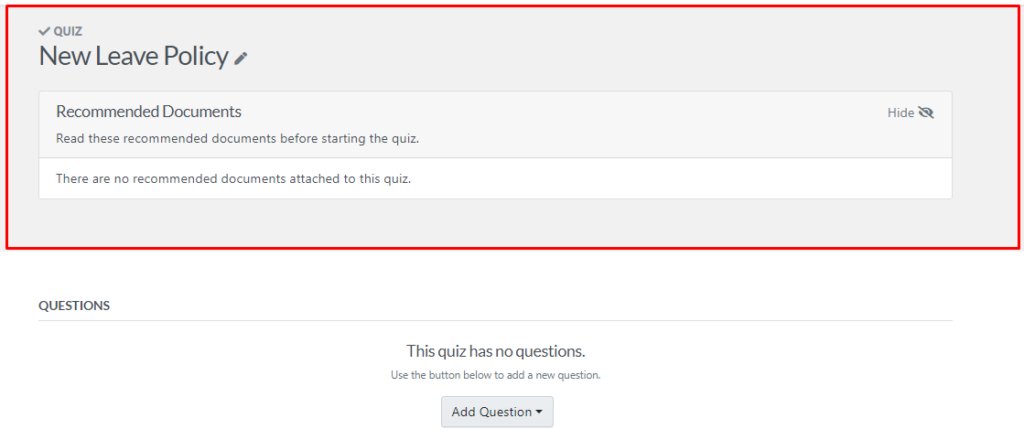

Step 9: Click “Save changes” after selecting your preferred duration and pass mark.
Step 10: Attach one or more related documents to this quiz to enable a cohesive learning and testing environment.

Step 11: Approve the quiz after adding all the questions as required.
Sign up here to create your first quiz in SweetProcess at no cost.
8 Organizational Change Management Strategies for Driving Results
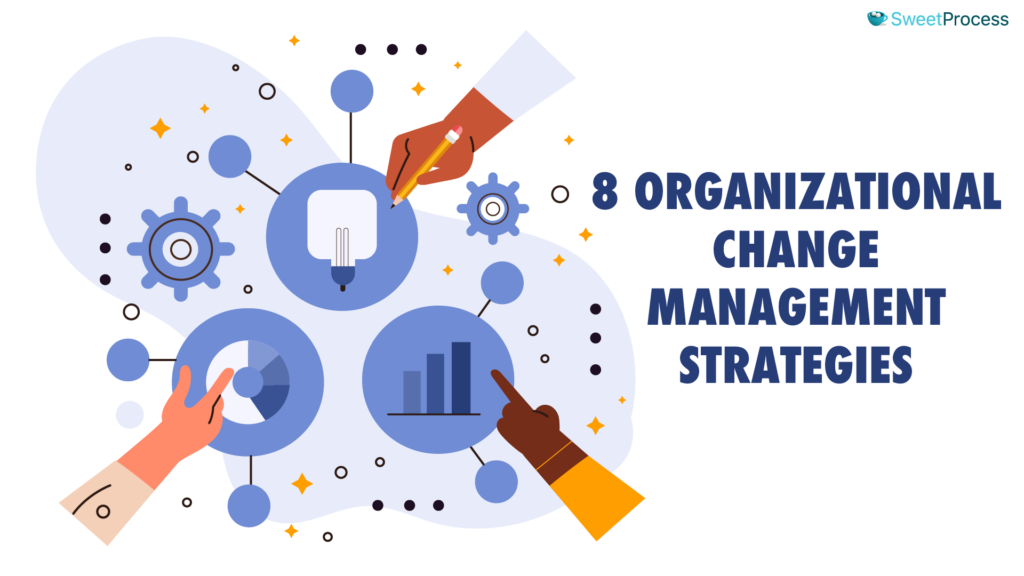
Whether adopting new technologies, restructuring, or shifting company culture, effective change management strategies are essential to ensure a smooth transition and positive outcomes. Here are eight proven strategies to help drive results and lead your organization through change with efficiency.
Put People First
Effective change management recognizes the power of people in driving transformation. Successful leaders prioritize engaging and empowering individuals who will bring about change. Change initiatives are doomed to fail without a clear understanding, belief, and active participation from those involved. By fostering a culture of open communication and proactive engagement, leaders can inspire a desire for change across the organization, increasing the likelihood of success. This approach aligns with the renowned Prosci change management methodology, refined over 20 years of research, and has trained and certified over 45,000 professionals worldwide. When people are invested in the change and motivated by their peers, the chances of success skyrocket.
Pay Attention to High and Low Points in Momentum
Change management initiatives inevitably experience fluctuations in momentum. Savvy leaders should recognize and capitalize on these highs and lows to drive success. Leaders should acknowledge and celebrate achievements during peak moments to sustain momentum and energize teams. Conversely, during challenging times, leaders can reassess their approach, solicit employee feedback, and foster trust and support through open communication. By proactively responding to these fluctuations, leaders can harness momentum and steer change initiatives toward great outcomes.
Make Change Compelling and Exciting
When organizations communicate with purpose, clarity, and consistency, employees are more likely to grasp the reasoning behind change initiatives. By providing context and addressing the “why,” “what,” and “so what” of change, effective communication resonates with employees and answers the question that matters most to them: “How will this impact my work, and what’s in it for me?” With a deeper understanding of the change, employees transform from mere compliance to active engagement and advocacy, asking, “How can I contribute to this change?” This shift in mindset is powerful, fostering a solid foundation of employee support that helps overcome resistance and propels the organization forward. Employee support deters change resistance that could hold the organization back.
Secure Buy-in From Your Entire Organization
To drive successful change, it’s essential to secure buy-in from all levels of the organization, from top management to entry-level employees. While top management’s support legitimizes the initiative and sets the tone for leadership, mid- and entry-level employees are crucial for ground-level implementation.
When all employees understand and believe in the change’s value and necessity, they’re more likely to be motivated, engaged, and cooperative, ensuring a smoother transition. Whenever possible, involving employees in decision-making or seeking their feedback can be a powerful strategy, fostering a sense of ownership and appreciation. This approach encourages diverse perspectives and helps uncover potential impacts that might have been overlooked, ultimately strengthening the change initiative’s success.
Build a Change Implementation Plan
Before presenting proposed changes to your team, ensure you have a well-defined strategy, addressing the essential questions of when, how, and why the change will occur. Ideally, your change action plan should include:
- A detailed task list outlining the steps necessary to achieve the desired outcome
- Clear definitions of new or modified responsibilities for impacted team members
- A thorough timeline outlining key milestones and deadlines
- Anticipated responses to address potential concerns and questions
A thorough plan will help you effectively communicate the change and ensure a smooth transition.
Don’t Ignore Resistance to Change
Change resistance can majorly hinder an organization’s growth and transformation. However, leaders can mitigate its impact by identifying and addressing resistance early on. Signs of resistance include inaction, procrastination, information hoarding, and rumor spreading.
Effective communication is crucial in detecting resistance, and leaders can create feedback loops through surveys, feedback channels, and input sessions to proactively identify and address concerns. By engaging employees and ensuring clear, consistent, and transparent communication, leaders can foster a culture that embraces change, driving successful organizational transformation and positioning their organization for long-term success. Remember, people are at the heart of change, and proactive employee engagement is the key to managing organizational change effectively.
Focus on Training & Support
When introducing technological or process changes, comprehensive training is essential to ensure employees are equipped to thrive in the new environment. Announce training opportunities concurrently with the change, alleviating concerns about skill gaps or inadequacy. By proactively offering training and support, you demonstrate a commitment to employee development and empowerment, fostering a smooth transition and enabling employees to master the new technologies and processes with confidence. This proactive approach helps build trust, mitigates anxiety, and encourages a growth mindset within your team.
If you need a tool to facilitate the onboarding of your new and existing employees, SweetProcess could be the solution.
Work With a Change Management Model
Leaders face significant challenges when driving change, including entrenched company culture, organizational inertia, and human psychological factors. To succeed, they need effective tools and guidance. Change management models provide a structured approach to translating business strategy into action, significantly increasing the likelihood of successful transformation. Various models exist, such as Prosci’s ADKAR, Lewin’s Change Management Model, and Kotter’s 8 Steps for Leading Change. While each model has unique aspects, they share common principles: identifying needs, planning, and implementing change.
3 Organizational Change Management Examples You Can Learn From

Evolution of Amazon
In 1994, a humble garage in Seattle, Washington, was the birthplace of a revolutionary idea by Jeff Bezos. Amazon started as an online bookstore, pioneering the concept of virtual shopping. But Bezos’s vision didn’t stop at books. With a passion for innovation and customer satisfaction, Amazon rapidly evolved into a multifaceted e-commerce giant, offering a vast array of products, from electronics to toys, clothing, and beyond. This modest garage startup would eventually disrupt the retail landscape, forever changing the way we shop and experience the world of commerce.
The year 1997 marked a pivotal moment in Amazon’s journey, as it went public and embarked on a path of unprecedented growth. By year’s end, the company had not only spanned all 50 US states but also reached customers in over 160 countries worldwide. The 2000s were a decade of innovation, as Amazon unveiled groundbreaking services like AWS (2006), revolutionizing cloud computing, and the Kindle e-reader (2007), transforming the way we read. With each milestone, Amazon’s impact on global commerce, technology, and culture continued to multiply, solidifying its position as a trailblazer in the digital age.
Amazon’s remarkable journey reached new heights by 2010, making it the world’s largest online retailer. With a vast array of products at its customers’ fingertips, Amazon’s global reach knew no bounds. But that was just the beginning. In the following years, Amazon continued to push boundaries, venturing into uncharted territories like groceries, healthcare, and entertainment. Fast forward to today, and Amazon stands as a global giant, boasting a staggering market capitalization of over $1.5 trillion and a workforce of over 1.3 million talented individuals.
Changes and Change Management at Amazon
As Amazon continues to push the boundaries of innovation, effective change management has become a crucial aspect of its success. With the speed of competition and innovation at Amazon, they must be change-responsive to stay ahead. Effective change management is the key here, enabling the company to harness the power of change and turn it into a competitive advantage. Without it, Amazon risks being left behind its competitors.
However, Amazon’s size and scale can make change management particularly challenging. With more than 1.3 million employees and operations in numerous countries around the world, implementing changes across the organization can be complex and time-consuming. Effective change management processes are essential to ensure that changes are communicated clearly and effectively to all stakeholders and that the changes are implemented to minimize disruption to the business.
The need for change management at Amazon is driven by the company’s growth and the ever-changing nature of its business environment. By effectively managing change, Amazon has continued to stay ahead of the curve and remain a leader in the global marketplace.
Major Change Case Study at Amazon: Acquisition of Whole Foods
In 2017, Amazon announced the acquisition of Whole Foods, a high-end grocery store company specialized in organic and locally produced items. Amazon’s $13.7 billion acquisition signified its adoption of the food business and was viewed as a possible game changer in the industry.
The deal was completed in 2017, and Amazon quickly began to integrate Whole Foods into its business operations. Some of the changes accompanying this acquisition include implementing changes to the store’s pricing, product offerings, and supply chain. The acquisition also paved the way for innovations in the grocery industry, such as the launch of Amazon Go, a cashierless convenience store that uses AI and computer vision technology to track purchases.
Analysis of the Change Management Process Used by Amazon
Amazon’s change management process during the acquisition of Whole Foods was thorough, well-planned, and effectively executed. Amazon successfully integrated Whole Foods into its business and innovated in the grocery industry. This was made possible by emphasizing communication, training, cultural integration, and flexibility.
- Planning: Amazon spent a significant amount of time planning for the acquisition and identifying the key changes that would need to be made to integrate Whole Foods into its business. The identified changes included identifying potential synergies, integrating supply chains, pricing strategies, and assessing the impact of the acquisition on employees and customers.
- Communication: Effective communication was a critical component of the change management process. Amazon made a concerted effort to communicate the changes to all stakeholders, including employees, customers, and investors. The company emphasized its commitment to maintaining Whole Foods’ brand identity and values, while also highlighting the potential benefits of the acquisition for customers and employees.
Amazon’s communique, released on June 16, 2017, explained how Amazon and Whole Foods had entered into a definitive merger agreement under which Amazon acquired Whole Foods Market for $42 per share in an all-cash transaction valued at approximately $13.7 billion, including Whole Foods Market’s net debt. This shows how concerned they are about detailing legal communications and giving enough information to all stakeholders.
- Training and Education: To prepare Amazon and Whole Foods employees for the changes, Amazon provided extensive training and education programs to the employees. This included training on new technology, changes to store operations, and even the popular anti-unionization training.
- Flexibility and Agility: Amazon was flexible and agile in its approach to the change management process. Based on feedback from employees and customers, the company made adjustments as needed and was willing to pivot its strategies when necessary.
- Cultural Integration: Amazon recognized the importance of cultural integration in the change management process. The company worked to integrate the two organization’s cultures and ensure that Whole Foods employees felt valued and supported during the transition. According to Forbes, Whole Foods retains its culture while benefiting from aspects of Amazon’s culture and operations that are critical to compete in the grocery business, such as expertise in logistics, customer intelligence, and agile decision-making. Even in its early days, the marriage of these industry leaders appears to be creating positive customer value.
For all businesses going through structural changes like a merger or acquisition, a well-planned and executed change management framework is an important factor in what the end product will look like. Thoughtful change management and collaborative business process management practices are what you need to replicate Amazon’s success.
Toyota Production System
Toyota, a Japanese multinational automotive manufacturer, was founded in 1937. The company is well-known for its innovative and efficient production system, the Toyota Production System (TPS), which has become a model for manufacturing excellence. Today, Toyota is one of the largest automakers in the world, with a reputation for quality, reliability, and innovation.
TPS is more than just a collection of tools and concepts; it is also a philosophy and way of working that incorporates change management at all levels of the organization. Toyota’s approach to continuous improvement is known as Kaizen, and it has become a central part of Toyota’s culture and way of working.
Toyota Production System
The Toyota Production System (TPS) is a lean manufacturing system developed by Toyota. It focuses on reducing waste and maximizing production efficiency.
The two key principles of TPS are:
- Identify and eliminate all forms of waste in the production process
- Continuously improve the production process.
The Two Pillars of TPS
The Toyota Production System’s core philosophy is built on two pillars.
The first pillar is jidoka, which translates to “automation with a human touch.” It focuses on preventing defective products and improving productivity by eliminating the need for humans to monitor machines.
The second pillar is just-in-time (JIT), which synchronizes production processes and ensures continuous flow by producing only what is needed at the right time and in the right quantity.
Other concepts that contribute to the success of TPS are:
Lean Management
Lean management is a component of lean manufacturing, which has the overall goal of eliminating waste from the workplace. This includes wasted time, wasted products, and wasted services. Even minor improvements that eliminate waste from a process can amount to quite a bit over time. Therefore, lean management focuses on how businesses can operate more efficiently and what the management team can do to help.
Kaizen Philosophy
Continuous improvement is so fundamental to TPS that it deserves its name. Kaizen is a Japanese term for continuous improvement. While Kaizen strategies are undoubtedly interested in finding ways to make large-scale improvements, they also pay attention to the small details. If Toyota can find a way to reduce the amount of physical waste produced when manufacturing one car by just one percent, the saved waste will be significant over time.
Toyota’s Kaizen initiative is about more than just waste elimination. It also seeks to continuously improve the quality of the products it produces, which begins with the company’s employees. Improving people, from CEO to assembly-line worker, will improve the company.
The Kanban System
Kanban is a manufacturing scheduling strategy, known as TPS’s just-in-time manufacturing system. Rather than keeping a large inventory of every automobile part required for the products being manufactured, systems using the Kanban Toyota strategy will keep only as many as are needed for a given period of time.
When a specific part is running low, the Kanban system notifies the supplier so that more can be delivered. When everything goes as planned, the new shipment will deliver the parts to the production line where they are needed, just as the previous one did. Operating in this manner allows a company to reduce the risk of being stuck with a large quantity of a particular part if demand suddenly drops. It also eliminates the need for large storage areas to store these types of raw materials.
Changes and Change Management at Toyota
TPS incorporates change management through a system known as Hoshin Kanri, which takes a top-down approach to strategic planning and goal setting. In this system, senior leaders establish the organization’s direction before collaborating with middle managers and front-line employees to implement changes and improvements consistent with the overall strategy. This ensures that change is managed, structured, and coordinated throughout the organization, with everyone working toward the same objectives.
Toyota’s approach to change management is grounded in its core values of respect for people and continuous improvement. The company has a long history of successful change initiatives that have allowed it to stay at the forefront of the automotive industry.
Major Change Management Case Study at Toyota: Decentralizing Decision-Making Process
Hoshin Kanri, Toyota’s change management strategy, emerged from the quality movement in the 1960s. The first adoption was in 2001, when Toyota fully utilized Hoshin Kanri in Japan, but it was not yet applied to its overseas operations.
The challenge was to figure out how the system could help Toyota transform business quickly from one of a “subsidiary” function—reporting to our Japanese headquarters—into one of a self-reliant, team-oriented, and independent organization that operated less dependently on Japan headquarters but as a single unit in North America.
The Hoshin Kanri framework is a systemic approach for defining a strategy and, more importantly, a management system that engages all people to support that strategy while building horizontal and vertical alignment.
The steps are:
- Cascade Hoshin objectives vertically in the organization, clarifying the “why” at each level
- Build alignment both vertically and horizontally to our corporate objectives through problem breakdown and individual problem-solving
- Achieve horizontal alignment to objectives across the company
According to the Toyota management team, while giving a detailed explanation on how they made the system work, they said:
“As the first step in building alignment and teamwork, we brought together our North American executive team to establish a 2010 North American Manufacturing (NAM) vision based on Toyota’s global vision. We built four key initiatives in the core: customer satisfaction, cost reduction, supplier enhancement, and people development—each of which had clearly defined executive leadership.
“In the end, we built a rigorous management system that:
- Narrowed our core objectives to major items on our 2010 vision
- Defined each objective as a problem to solve, which helped us “clarify the need,” as Mr. Ohno said
- Established cross-functional support teams that ensured both vertical and horizontal alignment to our objectives
- Created a clear PDCA structure to ensure progress was tracked and not impeded by siloed goals
- Focused on rigorous execution by breaking down the high-level objectives to specific, actionable countermeasures at the working level (shown in the Hoshin framework).”
Toyota accomplished this strategic change in about six months, thanks to a new, self-reliant management system that created a PDCA (plan, do, check, act) structure within Toyota North American manufacturing. This new structure set the stage for several other critical changes they made over the next several years.
Analysis of Toyota’s Hoshin Kanri Change Management Process
- Building teamwork across headquarter functions, between the headquarters and the plants, and among the plants. This was done by assigning people to cross-functional teams and building executive teamwork.
- Developing leadership capabilities to manage at a higher level because the system requires that they think about problems one level above their authority. For example, a plant manager was assigned to lead supplier development for all of North America in collaboration with their TMMNA (Toyota Motor Manufacturing North America) head of purchasing at headquarters.
- Success required breaking down problems to the working level and engaging all levels of the organization to solve them, innovate, and think of their jobs differently. Because they were working with a large team of about 30,000 people, success required strong alignment with corporate goals and purpose.
Even though not everything changed in six months, the structure put in place in the first six months helped Toyota weather the upcoming storms. Toyota’s successful implementation of change has significantly impacted the company, its employees, and the automotive industry as a whole.
How the Hoshin Kanri strategy works in other organizations:
- Bring your team together and discuss your primary goals. If you lead a big business, the process starts with the executive team; if small, it would be the whole team.
- Define a few core objectives to focus on in the next six months. A year may be too long in some situations.
- Build vertical alignment both ways, allowing frontline workers to contribute innovative ideas that help the company achieve its goals.
- Establish horizontal alignment across functions, which will most likely necessitate abandoning traditional KPIs that measure people based on functional performance and assigning people to positions where they are uncomfortable and must learn new skills.
- Define a clear management system based on Hoshin Kanri—fixed and flexible, with clear standards for PDCA and the ability to adjust as needed.
The Hoshin Kanri approach to strategy deployment allows your company to engage and motivate all levels of the organization to participate in new, innovative ways of thinking. Adopting the system will also help everyone feel more connected to the company’s purpose and colleagues during a critical time of change.
Apple’s Revolution
Apple Inc. was the brainchild of Steve Jobs, Steve Wozniak, and Ronald Wayne. Since its inception on April 1, 1976, it has transformed from a humble garage start-up into a global technology powerhouse. The trio’s vision was to develop and sell personal computers. Their first product was the Apple I, hand-built entirely by Wozniak and marketed by Jobs.
Apple I was introduced at the Homebrew Computer Club in Palo Alto, California, marking the beginning of a technological revolution. Despite the company’s modest beginnings, its vision was to bring an easy-to-use computer to the market. In 1977, Apple was incorporated without Wayne, who sold his share back to Jobs and Wozniak for $800. The same year, the company launched the Apple II at the West Coast Computer Faire, propelling Apple into the forefront of the burgeoning personal computer industry.
Changes and Change Management at Apple
A noteworthy change to Apple computers occurred in 2007 when Apple officially dropped “Computer” from its name to become Apple Inc. This shift reflected the company’s expanded focus beyond personal computers to a broader range of consumer electronics, including the iPhone, iPod, and the iPad.
Apple’s expansion into new product categories, such as smartphones, tablets, wearables, and services, necessitated a brand strategy that could encompass a broader range of offerings.
As Apple established itself as a global technology leader, it needed a brand identity that went beyond its computer company roots. The shift to “Apple Inc.” reflected a more comprehensive and future-oriented brand image.
Apple’s brand evolution resulted in a transformational change that was widely regarded as successful. The company’s brand is synonymous with innovation, sleek design, and a smooth user experience. The cohesive integration of hardware, software, and services has contributed to Apple’s strong and recognizable brand identity.
Consumers have responded positively to the minimalist design approach, both in terms of product aesthetics and marketing. Apple’s brand is often associated with premium quality, cutting-edge technology, and a user-friendly ecosystem.
Major Change Case Study at Apple: Rebranding from Apple Computers to Apple Inc.
In the late 1990s, Apple was on the brink of collapse, struggling with a convoluted product line and dwindling consumer interest. The turning point came in 1997 with the return of Steve Jobs, who had co-founded the company two decades earlier. Jobs swiftly initiated a series of bold changes, starting with a dramatic overhaul of Apple’s product line. He slashed numerous failing projects and refocused the company’s efforts on a few key innovations. The launch of the iMac in 1998 was a defining moment. Its distinctive, colorful design and user-friendly interface marked the beginning of Apple’s transformation. The iMac was more than just a product; it symbolized a new era of simplicity, elegance, and consumer-centric technology.
In 2007, reflecting the company’s broadened vision, Jobs announced that Apple Computer, Inc. would become Apple Inc. This rebranding signaled a shift from a focus on personal computers to a wider array of consumer electronics. The iPod had already revolutionized the music industry, and the iPhone, introduced the same year, would soon redefine the smartphone market. Apple’s meticulous attention to design and innovative marketing campaigns like “Think Different” helped forge a strong, distinctive brand identity. The rebranding was not merely cosmetic; it was a strategic evolution that positioned Apple as a leader in technology and innovation, setting the stage for its emergence as a global powerhouse.
Analysis of Change Management at Apple During Its Rebranding
Apple’s transformation from Apple Computers, Inc. to Apple Inc. is a textbook example of effective change management in a corporate setting. Strategic decisions, innovative products, and a redefined corporate vision marked this transformation. Here are key aspects of how Apple managed this change:
Visionary Leadership
When Steve Jobs returned to Apple in 1997, he brought a clear vision and decisive leadership. He focused on innovation, simplifying the product line, and creating a cohesive brand identity.
Tim Cook’s operational excellence after Jobs maintained the company’s innovative culture while streamlining operations and expanding Apple’s global footprint.
Product Innovation
The launch of the iMac in 1998 marked the beginning of Apple’s resurgence. It was not just a new product but a symbol of Apple’s commitment to innovative design and user-friendly technology. iPod, iPhone, and iPad also redefined their respective markets. The iPod transformed the music industry, the iPhone revolutionized the smartphone market, and the iPad created a new category of computing devices.
Brand and Identity Shift
By dropping “Computers” from its name in 2007, Apple signaled its broader focus on consumer electronics and digital content. Apple’s marketing campaigns (like the “Think Different” campaign) also helped to create a strong brand identity that appealed to a broad audience.
Corporate Culture and Innovation
Apple fostered a culture of innovation that encouraged creativity and innovation. This was supported by significant investment in research and development.
Strategic Acquisitions and Ecosystem Expansion
Apple acquired companies that provided technology or talent essential to its product development, such as acquiring P.A. Semi for chip design.
Apple also created an ecosystem of products and services that work seamlessly together, including hardware (Mac, iPhone, iPad), software (macOS, iOS), and services (iCloud, Apple Music, App Store).
Operational Efficiency
Under Tim Cook’s leadership, Apple significantly improved its supply chain management, reducing costs and increasing efficiency. The introduction of Apple Stores is another change that provided a direct sales channel and a unique customer experience, enhancing brand loyalty.
Customer Focus
Apple’s focus on delivering a superior user experience helped build a loyal customer base. This includes intuitive interfaces, high-quality products, and strong customer support. During the change process, Apple paid close attention to customer feedback and continuously iterated on its products to meet and exceed customer expectations.
Financial Management
Strong financial management, including prudent investments in new technologies and a healthy balance sheet, supported Apple’s transformation.
By addressing change on multiple fronts—leadership, product innovation, brand identity, corporate culture, strategic acquisitions, operational efficiency, customer focus, and financial management—Apple successfully transitioned from a struggling computer manufacturer to a leading global technology company. This multifaceted approach allowed Apple to manage change effectively and maintain its position as a market leader.
5 Common Challenges (and Solutions) to a Seamless Organizational Change Management

Disconnect Between Strategy and Culture
One of the biggest red flags in your organization is a change management strategy that is incompatible with your organizational culture. Change efforts that contradict your culture are likely to be met with resistance and distrust. Employees are more likely to trust and support proposed changes that are in line with your organization’s shared vision and goals.
Solutions:
– Assess your organization’s culture and vision realistically
– Ensure senior management and frontline employees are aligned on priorities, goals, rewards, and risk tolerance
– Communicate how your change supports your organization’s shared vision
– Get everyone on the same page before initiating change. It’s the key to a successful transformation!
Setting Unrealistic Expectations
When initiating change, avoid the common pitfall of pushing too hard, too fast, or too far. Rushing increases the likelihood of errors, burnout, and change fatigue. Remember that lasting change takes time.
Pressure to rush can be caused by market competition, highly optimistic top management, or the need for momentum.
Solutions:
– Manage both positive and negative expectations
– Remind yourself and your stakeholders that true change takes time
– Set realistic goals and timelines with short-, mid-, and long-term objectives
– Celebrate small wins to maintain momentum without burnout
– Pace your change initiative for success, not speed
Failing to Identify and Address Resistance
Every change initiative will encounter resistance; it is human nature! People prefer to stick to the established ways of doing things. They resist because they are uncomfortable with the unknown, are misaligned with their goals, are concerned about the impact on their role or job security, or do not trust management. If unaddressed, resistance can derail change efforts.
Solutions:
– Assess potential resistance from the start
– Tailor your communications strategy to address concerns proactively
– Engage in active listening throughout the change project
– By listening and addressing fears and anxieties, you can minimize friction and ensure a successful transformation. Remember, change management is about managing movement and friction—make it a smooth journey.
Alister Wood shared his firsthand experience of using incremental change to move his company, VisitUs, in the right direction and how resistance will always happen.
He said, “I’ve had to make two transformational changes recently. The first was hiring remote staff, and the second was expanding the business internationally. Both of these needed effective communication with employees for the correct execution and identification of those resistant to remote work. We focused on these employees and convinced them to make the change to improve their development and business health. The expansion took less convincing, but it was important to share every step with all employees so that we were all on the same page.”
He declared that effective communication with all employees is an important aspect of organizational change management.
Lack of Effective Communication
Do you want to know the secret of successful change management? It all starts with good communication!
Statistics show that many managers, frontline supervisors, and other employees do not understand the need for change in their organizations. This is due to poor communication.
You don’t just announce changes and expect employees to adapt. Instead, create a two-way dialogue where they feel heard and involved. This fosters a positive and inclusive atmosphere that leads to successful change.
Adopt SweetProcess today and collaborate seamlessly with your team members.
Starting With an Incomplete or Poorly-Defined Strategy
A common mistake among organizational change leaders is starting a change process with a bad strategy. Transformatives in your organization are not just about what, why, and how. Failing to prioritize a comprehensive change management strategy can derail your entire effort.
Short-term decisions can sabotage long-term goals without a clear plan, leading to unintended consequences. It can also make building a solid guiding coalition and buy-in harder, hinder good employee communication, and create misunderstandings that diminish leadership credibility.
Solution
- Invest time and energy in a strategic change management plan before starting any initiative.
- Utilize established models like Kotter’s 8 Steps for Leading Change, Lewin’s Change Management Model, or Prosci’s ADKAR Model as a foundation for your unique strategy.
- Don’t leave transformation to chance; instead, plan for success!
Document and Manage New Changes in Your Company Seamlessly
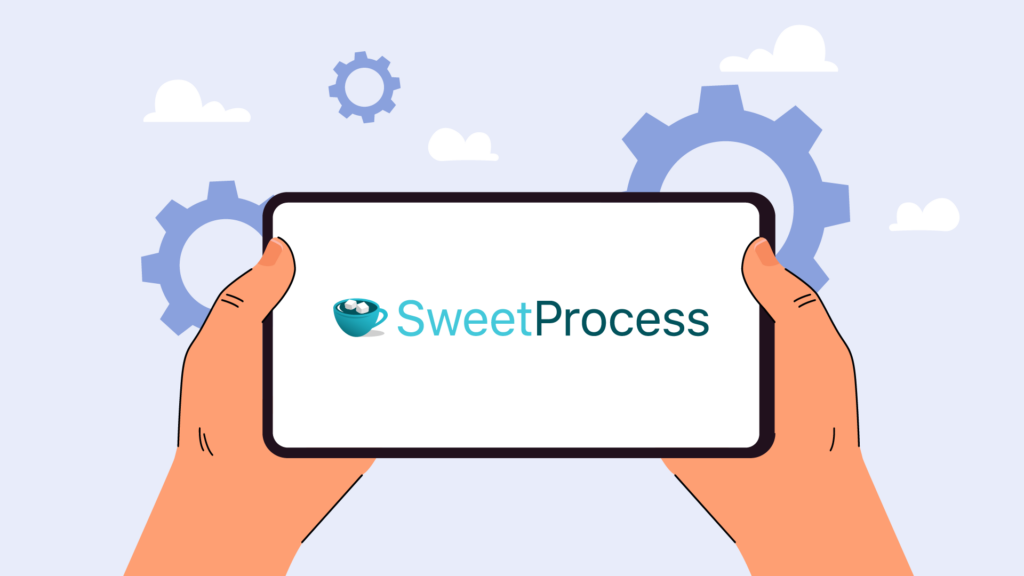
Since changes will always happen in your organization, you must learn to manage them effectively to drive success.
You should document all your ideas and processes using the right documentation tool to ensure they are not left to chance.
SweetProcess, a process documentation tool, has helped companies like Spark Marketer and Independent Retirement manage organizational change without stumbling.
Documentation is essential for successful change management. It provides clarity and consistent communication, which are crucial for aligning all stakeholders. Good process documentation software will house detailed instructions, guidelines, and standardized information, reduce misunderstandings, and ensure everyone understands the new processes or technologies.
Documentation also aids in training and onboarding by offering comprehensive materials like user operation manuals and how-to guides, ensuring that both new and existing employees can quickly adapt to changes.
